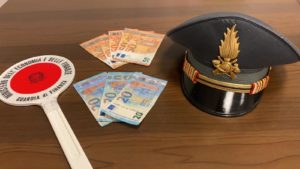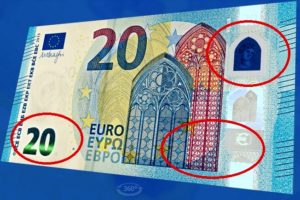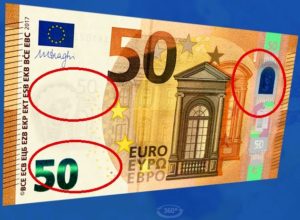What are the banknotes’ favorite counterfeiters?
These are the banknotes that circulate the most and unfortunately on which the least attention is paid: the 20 and 50 Euro banknotes
 Counterfeiters continue to favor 20 and 50 euro denominations for counterfeiting. This is what emerges from the data of the Bank of Italy that tells us how 46,470 banknotes recognized as counterfeit were withdrawn from circulation in the second half of 2019. In the data – however alarming – there is a positive news: it is in fact a number down by 13% compared to the same period of 2018.
Counterfeiters continue to favor 20 and 50 euro denominations for counterfeiting. This is what emerges from the data of the Bank of Italy that tells us how 46,470 banknotes recognized as counterfeit were withdrawn from circulation in the second half of 2019. In the data – however alarming – there is a positive news: it is in fact a number down by 13% compared to the same period of 2018.
The security measures of the new banknotes did not deter counterfeiters. This is because these are precisely the denominations of banknotes that circulate the most and on which the least attention is paid, so much so that the experts of the Bank of Italy have observed an increase in low-quality counterfeiting, with anything but accurate reproductions of the security features.
How to recognize counterfeit banknotes with certainty?
If you want to be sure not to run into unpleasant episodes, there is only one solution. Purchase a banknote detector just like the ones you find on this website. Only in this way will you protect your takings from aspiring scammers.
Although there are tricks to find out which banknotes are counterfeit or not, like the ones we will see below, this remains the only safe way apart from taking them directly to the bank or post office to have them checked.
But if you don’t have a banknote counting machine, how do you do it?
Here are some useful tricks to recognize the fake 20 and 50 euros
 20 euro counterfeit: how to recognize counterfeit banknotes
20 euro counterfeit: how to recognize counterfeit banknotes
The 20 euro banknote is inspired by the Gothic architectural style of the thirteenth and fourteenth centuries. Touching the banknote on the front you can perceive the dashes in relief along the right and left margins. In addition, the main image, the inscriptions and the large figure indicating the value of 20 euros are printed in relief.
On the 20 euro notes there is a portrait of Europe, a figure from Greek mythology, which enriches banknotes with a human face. The figure appears holding a banknote against the light, on the left together with the figure worth 20 euros. On the right, the window in the hologram reveals, in transparency, the portrait of Europe on both sides of the ticket.
By moving the banknote, the brilliant figure in the lower left corner changes color from emerald green to dark blue and produces the effect of a light that moves vertically. On the right, the silver strip reveals the portrait of Europe, a reproduction of the main image and the figure of the value.
In addition, from the second series the acronym of the European Central Bank appears in nine language variants (ECB ECB ЕЦБ EZB EKP EKT EKB BĊE EBC). The name of the coin is written in Cyrillic characters (EBPO) following Bulgaria’s accession to the European Union in 2007, as well as in Latin (EURO) and Greek (EYPΩ) characters. The map of Europe on the back of the second series banknotes also includes Malta and Cyprus.
 50 euro counterfeit: how to recognize counterfeit banknotes
50 euro counterfeit: how to recognize counterfeit banknotes
As in the 20 euro banknote, a portrait of Europe appears in the 50 euro banknotes from the second series. The figure appears holding a banknote against the light, on the left together with the figure worth 50 euros. On the right, the window in the hologram reveals, in transparency, the portrait of Europe on both sides of the ticket.
By moving the banknote, the brilliant figure in the lower left corner changes color from emerald green to dark blue and produces the effect of a light that moves vertically. On the right the hologram, i.e. the silver strip on the right, reveals the portrait of Europe, a reproduction of the main image and the figure of the value.
The 50 euro banknote is inspired by the Renaissance architectural style of the 15th and 16th centuries. Touching the banknote on the front you can perceive the dashes in relief along the right and left margins. In addition, the main image, the inscriptions and the large figure indicating the value of 50 euros are printed in relief.
Finally, the discourse on the linguistic variants traceable on the surface of the banknotes that we have explained for the 20 € banknotes is the same also for the 50 € banknotes.

